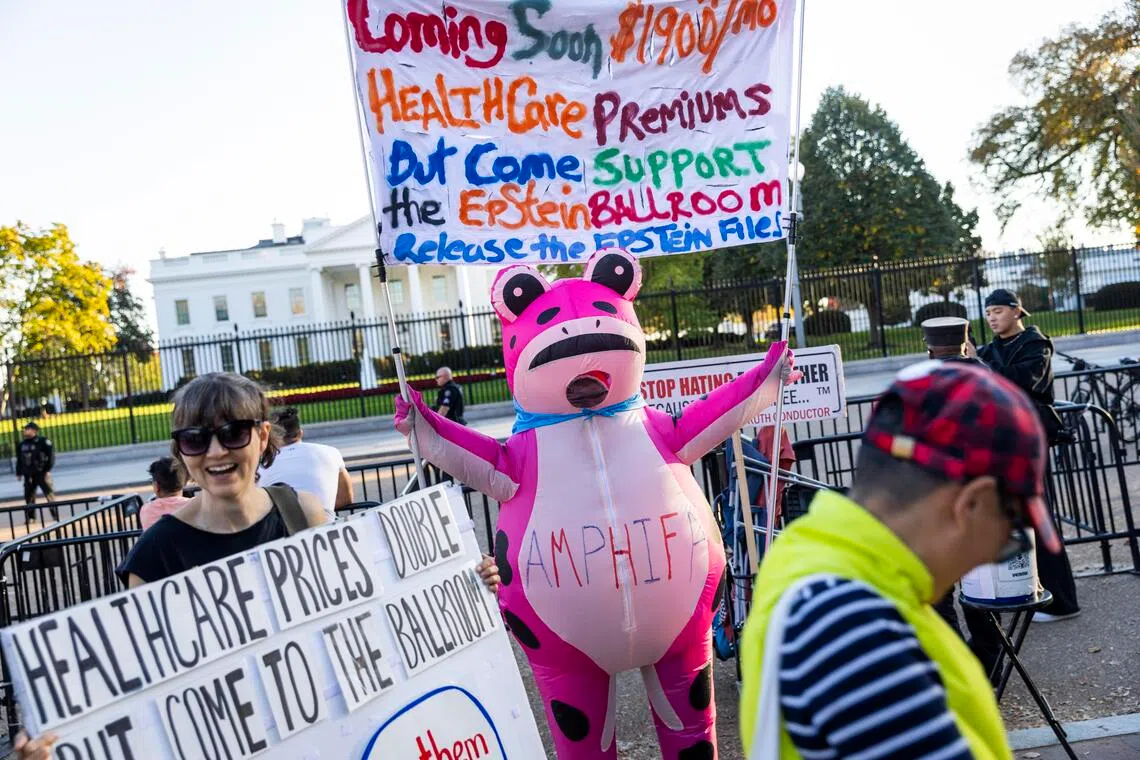US government shutdown enters record 35th day as congressional inaction takes toll
Sign up now: Get ST's newsletters delivered to your inbox

A protester dressed as a frog taking part in a demonstration outside the White House against rising healthcare costs.
PHOTO: EPA
Follow topic:
WASHINGTON – The US government shutdown
The toll increases by the day. Food assistance for the poor has been halted for the first time, federal workers from airports to law enforcement and the military are going unpaid, and the economy is flying blind with limited government reporting.
The Senate has voted more than a dozen times against a House of Representatives-passed stopgap funding measure, and no lawmakers have changed their position.
Mr Trump’s Republicans hold a 53-47 majority in the Senate but need votes from at least seven Democrats to meet the Chamber’s 60-vote threshold for most legislation. Democrats are withholding their votes to extract an extension of some healthcare insurance subsidies.
“The victims of the Democrats’ shutdown are starting to pile up,” Republican Senate Majority Leader John Thune said on Nov 3. “The question is how long are Democrats going to continue this. Another month? Two? Three?”
His Democratic counterpart, Senator Chuck Schumer, pointed out how Mr Trump’s attention has been focused elsewhere.
“While Donald Trump is bragging about remodeling bathrooms at the White House, Americans are panicking about how they will afford healthcare (in 2026),” Mr Schumer said, referring to a remodeling Mr Trump unveiled on Oct 31.
On Nov 3, however, there was talk rippling through the Senate that closed-door conversations between the two parties might be making some progress.
A shutdown unlike its predecessors
The 15th shutdown since 1981 stands out not just for its length. It has inverted the normal partisan dynamic in which shutdowns have often been provoked by Republicans.
In addition, little effort has been put into ending this latest shutdown. The House has been out of session since Sept 19, and Mr Trump has repeatedly left Washington.
“The political climate and the tensions that exist between the parties were so wide at the beginning of the shutdown, and even though bipartisan talks have continued through it, remain at this point still just as wide,” said Ms Rachel Snyderman, managing director of economic policy at the Bipartisan Policy Centre.
Food assistance
The Trump administration on Nov 3 said it would partially fund November food benefits but warned that it could take weeks or months for the aid to be distributed.
A portion of Head Start early learning programmes for low-income children also face some closed doors as new funding was not available on Nov 1.
Federal workers like law enforcement and members of the military are now missing pay cheques, as are airport security screeners and air traffic controllers, resulting in staffing challenges and travel delays.
More than 3.2 million US air passengers have been hit by delays or cancellations
The Congressional Budget Office estimated the shutdown could cost the US economy US$11 billion if it lasts another week. No federal funding means limited government data for the US Federal Reserve to pinpoint jobs and economic data as the central bank steers policy.
The American Federation of Government Employees, the largest union of federal workers, is pushing for a stopgap funding measure that the Democrats have voted against.

Food aid recipient Denise Malcom shops at a community market in Atlanta, Georgia.
PHOTO: EPA
Trump administration tests shutdown bounds
During the shutdown, Mr Trump has focused on foreign policy, from Gaza to Russia to Asia. But recently, he began digging in, calling for Republicans to abolish the Senate’s 60-vote filibuster threshold.
Asked if he could broker a deal, Mr Trump told CBS 60 Minutes on Nov 2: “I’m not gonna do it by being extorted by the Democrats, who have lost their way.”
On Nov 4, he again urged Senate Republicans to act or risk losing 2026’s midterm elections.
“Elections, including the Midterms, will be rightfully brutal. If we do terminate the Filibuster, we will get EVERYTHING approved... if we don’t do it, they are far more likely to do well in the upcoming Elections,” he wrote in a social media post.
Mr Thune repeatedly has rejected the idea.
Recent Reuters/Ipsos polling suggests that Americans blame both parties in Congress for the shutdown, with half saying most of the blame goes to Republicans and 43 per cent blaming Democrats.
Three moderate Democratic senators have voted with Republicans to reopen government, arguing the immediate harm of the shutdown outweighs any long-term gains. Some Democrats say they are holding out for Republican concessions in part to re-assert congressional funding powers in the face of Mr Trump’s executive overreach.
“The trust deficit has been there for a long time because of how Trump’s acted,” Senator Andy Kim, a New Jersey Democrat who has voted against the stopgap funding Bills, said in a hallway interview, “This is a big part of the challenge that we have before us right now: Any deal we get, how do know that a deal is going to be a deal?” REUTERS

